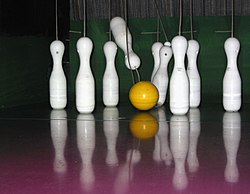Ninepin Bowling

Ninepin bowling pins and ball
|
|
| Highest governing body | WNBA |
|---|---|
| Nicknames | ninepins, 9-pin, kegel... |
| First played | Medieval times, Germany |
| Registered players | about 130,000 |
| Characteristics | |
| Contact | No |
| Team members | 6 per side + reserves |
| Mixed gender | Yes, separate competitions |
| Type | Team sport, ball sport |
| Equipment | Ninepin bowling ball |
| Venue | Ninepin bowling lane |
| Presence | |
| Olympic | No |
Nine-pin bowling (also known as ninepin bowling, nine-pins, 9-pins, kegel, etc.) is a bowling game played primarily in Europe. European championships are held each year. Over 90,000 members are on teams in Germany, often playing in officially registered Bundeskegelbahnen (federal bowling alleys) to be found in almost every sizable town. In Europe overall, there are some 130,000 players. Nine-pin bowling lanes are often found in Austria, Belgium, Luxembourg, the Netherlands, Estonia, Switzerland, Serbia, Slovenia, Croatia, Macedonia, Hungary, Brazil and Liechtenstein. The English-speaking countries, having a predominance of facilities for the modern ten-pin sport which originated in the United States, as well as regionally popular "small-ball" bowling sports of various types, do not have many facilities in existence for the nine-pin game in the 21st century. On the other hand, a modified version is played in the US state of Texas.
This game is played by rolling a ball down an alley towards nine pins. Unlike the ten-pin ball — and like the ones used for the eastern North American "small-ball" bowling sports of five pin bowling, candlepin and duckpin — the ninepin ball mostly has no holes for the fingers, though there exist special balls with two finger holes designed for novice players. The lanes are 19.5 m (64 ft) long and have no oil on them. The nine pins (literally known as "cones" in the local languages) are placed in a diamond shape on the alley. In modern lane systems the pins are reset by a pin-setter machine which lifts up the pins, each connected by a string on top, and lowers them back into the diamond shape for the next roll. The strings can be a positive factor for the bowler, as they can knock down other pins, or a negative factor, as they can get tangled up, though this is not always a problem as the machine can retract the strings for a short distance and allow a few seconds for them to untangle automatically. Compared with the ten-pin "free-fall" pin-setter, the string pin-setter has fewer moving parts, consumes less power, and costs less to maintain.
...
Wikipedia
